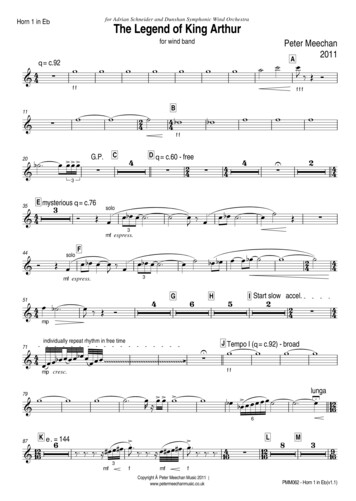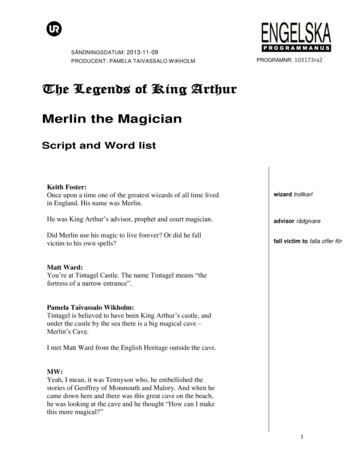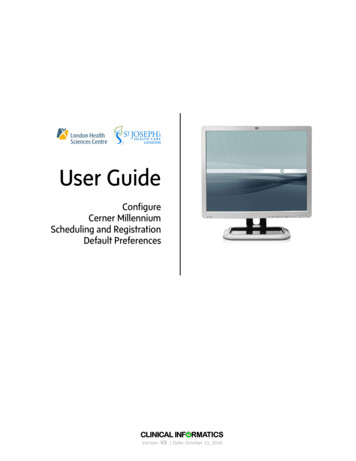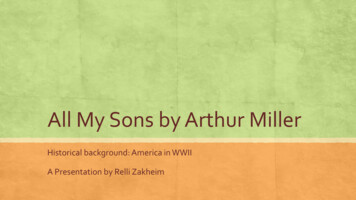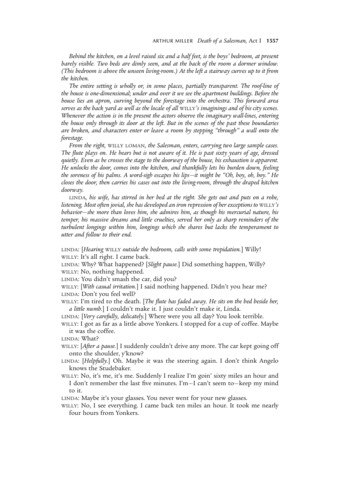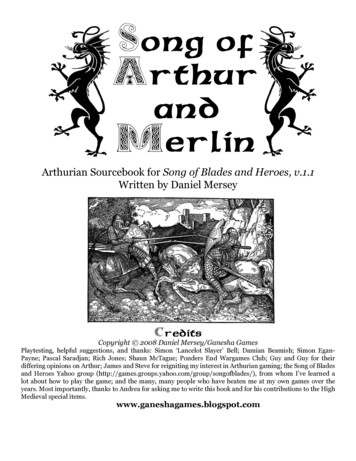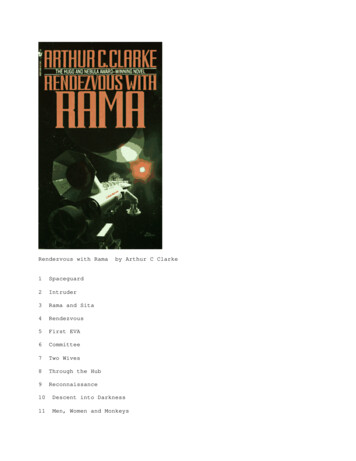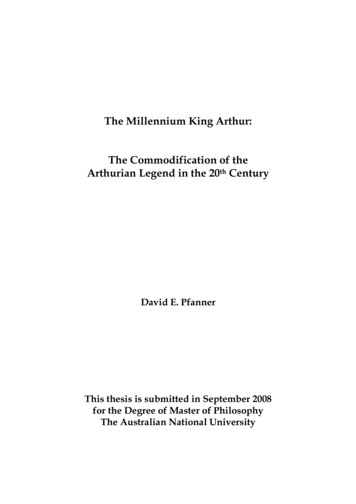
Transcription
The Millennium King Arthur:The Commodification of theArthurian Legend in the 20th CenturyDavid E. PfannerThis thesis is submitted in September 2008for the Degree of Master of PhilosophyThe Australian National University
Declaration of AuthorshipI hereby certify that the content of this thesis is my own work and that allsources used in its preparation have been acknowledged.Signature .Date .i
DedicationThis thesis is dedicated to the memory of my parents who would beastonished and delighted at this unusual undertaking by their son.ii
AcknowledgementsThe author particularly acknowledges the stimulation andencouragement of his supervisor, Dr. Rachel Bloul.The thesis could not have been written without access to the superbfacilities and staff of the Australian National University.In addition, the warm encouragement of many friends has beenappreciated.Finally, my patient wife has been generously supportive throughout thedrafting.iii
AbstractThe prophesy that King Arthur will return has come true. This legendaryicon of Western civilization lives again in the popular culture novels ofcontemporary and futuristic literature. While the king’s personality haschanged little since Malory, the monarch is now often found as asuperhero in new world settings: he has become a Celtic space travelleramong the stars, a modern politician fighting corruption, a WWII fighterpilot, a battler of aliens, and even returns as a teenage boy.Wherever he goes, King Arthur encounters a variety of personalised evilopponents from his medieval past as well as futuristic aliens andmonsters. The authors and publishers of Arthurian popular culture havecommodified the Arthurian legend, turning the king into anAmericanised romantic superhero who overcomes his opponents butmostly fails to meet the reality of modern socio-economic challenges.The king has a limited understanding of what constitutes evil in themodern world so that despite his worthy character as a role model, hisgrasp of action required to overcome injustice constitutes a majorshortcoming. The reasons for this are sought among the authors andpublishers that produced these novels, and among the literary critics andthe sociological literature focusing on the linkages between literature andsociety.iv
Table of ContentsDeclaration of Authorship.iDedication .iiAcknowledgements . iiiAbstract . ivTable of Contents .vIntroduction .1Core Legend.1Popularity, Persistence and Evolution of the Legend .4Methodology .6Chapter 1. King Arthur, Literature and Society .15Chapter 2. King Arthur Returns To Contemporary, Future, and OtherWorlds .24Chapter 3. King Arthur Arrives In The Contemporary World.35Chapter 4. King Arthur Emerges In Future and Fantasy Worlds.75Chapter 5. Other Arthuriana.113Chapter 6. The Identity, Character & Role of King Arthur : .121Chapter 7. King Arthur in Popular Culture.127Chapter 8. Women In The Worlds Of King Arthur .136Chapter 9. Authors and Publishers. .141Chapter 10. Values and The Americanisation of King Arthur.154Chapter 11. King Arthur As Hero And Superhero.158Chapter 12. King Arthur Confronts Evil—Or Does He?.167Chapter 13. Summary and Conclusions .178Grailpower .196Bibliography .197v
IntroductionKing Arthur has left Avalon, is alive and is among us now. Future worldsand lands of fantasy will all witness the return of the king as prophesied.This thesis reviews Arthur’s current and future literary reincarnationsand asks how he has weathered the centuries since he first came to ourattention. The complexity and variety of stories surrounding Arthur’slegend cannot possibly be captured in a brief summary, yet an outline ofthe major elements of the legend is necessary prior to discussing currentversions.Core LegendThe legendary King Arthur was conceived in a plot engineered by thewizard Merlin whose price demanded the child be given to him foradoption. This was the beginning of a long relationship with Merlin asArthur’s protector and advisor. The young Arthur first proved his statusas King by withdrawing his famous sword Excalibur from an anvilembedded in a large boulder, a sword later claimed from the Lady of theLake and ultimately returned to her as Arthur lay dying.A major threat to Arthur arose when the enchantress Morgan, his halfsister, seduced him with the resulting birth of their illegitimate son,Mordred. Merlin had warned Arthur that if Mordred lived he wouldbecome the king’s mortal nemesis. Nine months later, Arthur’s responsewas the premeditated mass murder of all newborn males in his realm byputting them out to sea. Only Mordred survived. The sin and guilt ofincest and infanticide haunted King Arthur ever after.A second threat to Arthur’s early reign was the intense rivalry amongcompeting petty monarchs who challenged Arthur’s hegemony. After1
many bloody battles, Arthur defeated his rivals, subdued the invadingSaxons and became the first overall king of a unified Britain. WhenArthur married Guenevere, her father gave him a Round Table and 100knights but she gave the king no heir.During a temporary peace in the conflict with the Saxons, the castleCamelot was built on a hill overlooking the Isle of Apples. Peace wasnever long lasting, and in some versions of the story, King Arthur went towar against the armies of Europe, defeated them and was crownedEmperor of Rome. Adding to the complexity of the plot, QueenGuenevere became romantically involved with Sir Lancelot du Lac, herfavourite knight who was loved by Arthur as well. This tragicrelationship with strong political overtones was never resolved. KingArthur could never escape the Queen’s infidelity with Lancelot, asituation endlessly embellished by numerous authors and scholars. TheKnights of the Round Table, also concerned over the lack of an heir to thethrone, urged Arthur to discipline or abandon Guenevere. They were senton quests to discover the miraculous Holy Grail. The discoverer turnedout to be Lancelot’s son, Galahad, from his marriage with Elaine.When King Arthur was away on the invasion of France, Mordred seizedthe throne of Britain and would have forced Guenevere to be his queenhad she not escaped. Hearing of this, the king returned from abroad tobattle Mordred’s forces. In hand-to-hand combat Mordred was killed byhis father who himself was mortally wounded by Mordred. AfterExcalibur was returned to the lake of its origin, four Queens took Arthurby boat to the fabled land of Avalon. According to some chroniclers,Arthur was not killed, but will return again in time of need.Hic iacet Arthurus Rex quondam Resque futurus2
The death of Arthur ended the tragedy of Camelot. Without a strongleader with vision and armies to combat the continued invasions ofSaxons, the realm fell into tatters. Guinevere went into a convent whereshe died, while Lancelot became a hermit and, according to someaccounts, went mad.It will be clear from even this brief summary that the character of KingArthur was a revered leader of men who excelled on the battlefield innumerous British and European campaigns. His vision of a unified Britainfree of foreign invaders, his success in bringing this about howevertemporarily, and the magic of Camelot are all elements that havesurrounded this heroic figure for generations. In the core legend KingArthur does not doubt his identity or role at court or on the battlefield.Whether or not King Arthur was a mythic warrior presiding over autopian Camelot, or a failed indecisive King whose inevitable downfallwas brought about by the sin of incest and infanticide is still beingdebated. Regardless of the ‘truth’ in the matter, the legend survives to beexamined and re-examined by scholars in several disciplines.There are a number of significant issues appearing in contemporaryreconstructions of the legend that are quite different from the core legendand which deserve brief mention. The major challenges confronting theking previously mainly arose in the form of rival kings, invading Saxons,the political instability and grief caused by the love affair betweenGuenevere and Lancelot. Note that these very real threats are human asopposed to the decidedly evil Morgan and Mordred together with nonhuman beings such as demons or aliens. The confrontation Arthur haswith these opponents is not structured in terms of good versus evil as isoften the case in later reconstructions. Finally, the Arthurian legend isbased on a mythical reformulation of the Middle Ages with associatedtrappings of the court, Christian values and those of heroism, loyalty,3
honour and chivalry. The early Arthuriad has a more complex socialcontext embracing the action than is given by contemporary authors.Popularity, Persistence and Evolution of the LegendThere has been an enormous increase in the popularity of Arthurianfiction in the post-war period, especially since the 1980s. (See RaymondH. Thompson’s Introduction to The Return From Avalon, 1985.) The focusof this thesis is on this limited period of about 25 years only. During thistime, new versions of the Arthuriad have grown to meet the burgeoningdemand for science fiction and particularly for fantasy. The currentpopularity of the legendary monarch is beyond dispute as he can befound in film, television productions, popular literature and even musicalcomedy. How do we account for this popularity when the king mustcompete with all manner of comparable heroes and superheroes such asThe Phantom, Superman, Batman, Spiderman as well as larger than lifecharacters in westerns, detective fiction, space opera and others? There issomething about the Arthurian legend, drawn mainly from the MiddleAges, that resonates deep within us as it reflects universal themes of goodvs. evil, heroism, honour, love, loyalty, shame and betrayal.The popularity of the Arthurian legend also results from the stature andcharacter of the mythical figure that King Arthur has occupied inliterature and public perception. The King of all Britain has been regardedas an ideal military leader and ruler over a nearly utopian societysymbolized in the court of Camelot. It was Nennius who was responsiblefor shaping King Arthur as the patriotic British Christian warrior, thevictor in the battle of Badon, and the defender of his nation. Thecircumstances surrounding Arthur’s ‘death’ adds to the mystery thatincludes belief in a secular saviour who will return in a time of need, acommon feature in several reconstructions of the legend.4
The impact of the Arthurian legend on the British public particularly andon Western literature cannot be exaggerated. Elizabeth Jenkins puts itwell when she writes:The development of the myth, the pertinacity with which peoplehave held to it, been eager to repeat and add to it, and see in it areflection of their own interests and needs is like nothing else inour history (Jenkins, 1975: 214).Archaeological and historical studies do not reveal the existence of a 5thor 6th century king known as King Arthur at the time he was thought toexist. The familiar legend of Arthur is actually based on a variety ofliterary productions from British and French sources in the Middle Ages.The earliest significant source in the development of the legend appearedfrom the pen of Geoffrey of Monmouth in the 12th century. It wasGeoffrey, in his History of the Kings of Britain, who first introduced thecharacters of Merlin, Guenevere and Mordred for example. The bestknown Arthurian saga however is that of Sir Thomas Malory, Le MorteD’Arthur, published in 1485. Malory combined the English chronicletradition with French romances that introduced the character of Lancelotdu Lac for the first time and established the tragic love affair betweenLancelot and Guenevere. There is no monolithic, integrated agreed-uponversion of the legend, but rather a multiplicity of tales producing a varietyof Arthurs and interpretations of his character. These recreations are stillproceeding, with some taking the form of historical fiction and othersranging from modern fiction to the genres of science fiction and fantasy.The writing of Arthurian fiction goes well beyond mere entertainment,however. Hoffman and Carley, contributors to Culture and the King, seethe legend as being used to reconfirm a culture’s self-perception and evenhelp to bring about shifts in self-perception (See Shichtman and Carley,1994:7). Stephen Knight’s Arthurian Literature and Society (1983) hasdemonstrated how the Arthuriad has been structured by shifting social5
conditions
The Phantom, Superman, Batman, Spiderman as well as larger than life characters in westerns, detective fiction, space opera and others? There is something about the Arthurian legend, drawn mainly from the Middle Ages, that resonates deep within us as it reflects universal themes of good vs. evil, heroism, honour, love, loyalty, shame and betrayal.
